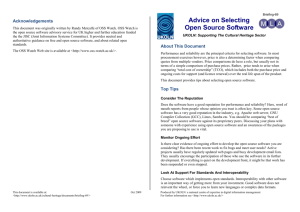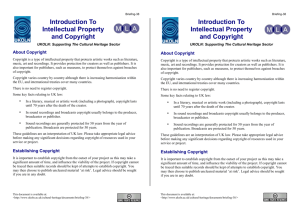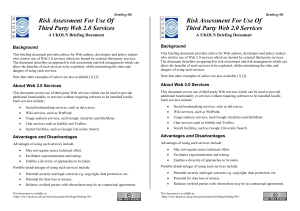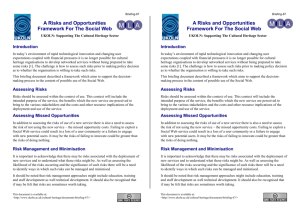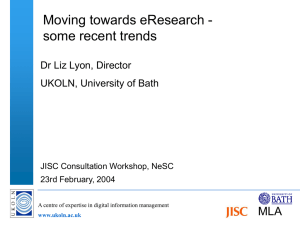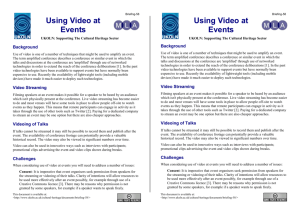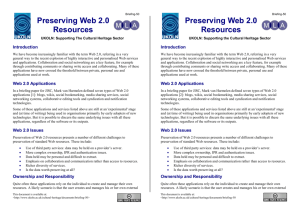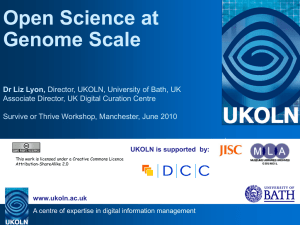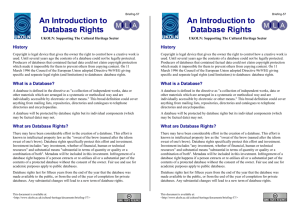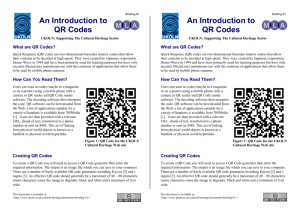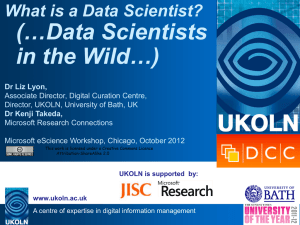Using The Risks and Opportunities Framework
advertisement
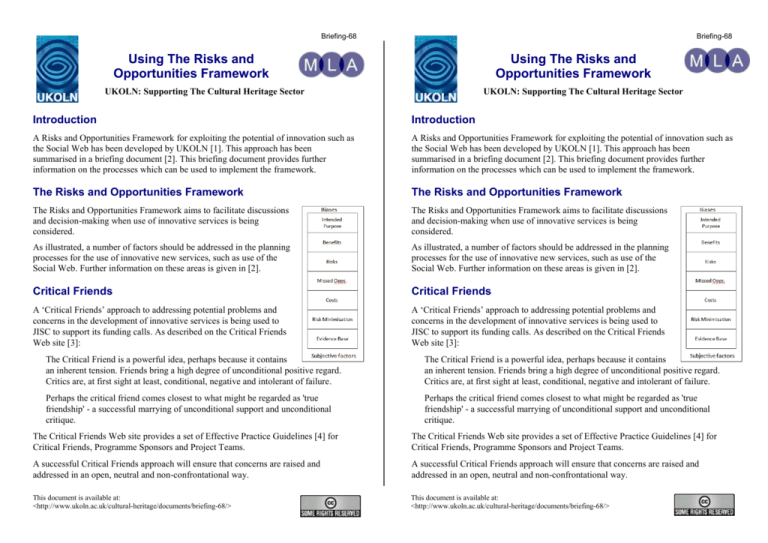
Briefing-68 Briefing-68 Using The Risks and Opportunities Framework Using The Risks and Opportunities Framework UKOLN: Supporting The Cultural Heritage Sector UKOLN: Supporting The Cultural Heritage Sector Introduction Introduction A Risks and Opportunities Framework for exploiting the potential of innovation such as the Social Web has been developed by UKOLN [1]. This approach has been summarised in a briefing document [2]. This briefing document provides further information on the processes which can be used to implement the framework. A Risks and Opportunities Framework for exploiting the potential of innovation such as the Social Web has been developed by UKOLN [1]. This approach has been summarised in a briefing document [2]. This briefing document provides further information on the processes which can be used to implement the framework. The Risks and Opportunities Framework The Risks and Opportunities Framework The Risks and Opportunities Framework aims to facilitate discussions and decision-making when use of innovative services is being considered. The Risks and Opportunities Framework aims to facilitate discussions and decision-making when use of innovative services is being considered. As illustrated, a number of factors should be addressed in the planning processes for the use of innovative new services, such as use of the Social Web. Further information on these areas is given in [2]. As illustrated, a number of factors should be addressed in the planning processes for the use of innovative new services, such as use of the Social Web. Further information on these areas is given in [2]. Critical Friends Critical Friends A ‘Critical Friends’ approach to addressing potential problems and concerns in the development of innovative services is being used to JISC to support its funding calls. As described on the Critical Friends Web site [3]: A ‘Critical Friends’ approach to addressing potential problems and concerns in the development of innovative services is being used to JISC to support its funding calls. As described on the Critical Friends Web site [3]: The Critical Friend is a powerful idea, perhaps because it contains an inherent tension. Friends bring a high degree of unconditional positive regard. Critics are, at first sight at least, conditional, negative and intolerant of failure. The Critical Friend is a powerful idea, perhaps because it contains an inherent tension. Friends bring a high degree of unconditional positive regard. Critics are, at first sight at least, conditional, negative and intolerant of failure. Perhaps the critical friend comes closest to what might be regarded as 'true friendship' - a successful marrying of unconditional support and unconditional critique. Perhaps the critical friend comes closest to what might be regarded as 'true friendship' - a successful marrying of unconditional support and unconditional critique. The Critical Friends Web site provides a set of Effective Practice Guidelines [4] for Critical Friends, Programme Sponsors and Project Teams. The Critical Friends Web site provides a set of Effective Practice Guidelines [4] for Critical Friends, Programme Sponsors and Project Teams. A successful Critical Friends approach will ensure that concerns are raised and addressed in an open, neutral and non-confrontational way. A successful Critical Friends approach will ensure that concerns are raised and addressed in an open, neutral and non-confrontational way. This document is available at: <http://www.ukoln.ac.uk/cultural-heritage/documents/briefing-68/> This document is available at: <http://www.ukoln.ac.uk/cultural-heritage/documents/briefing-68/> Gathering Evidence Gathering Evidence The decision-making process can be helped if it is informed by evidence. Use of the Risks and Opportunities Framework is based on documentation of intended uses of the new service, perceived risks and benefits, costs and resource implications and approaches for risk minimisation. Where possible the information provided in the documentation should be linked to accompanying evidence. The decision-making process can be helped if it is informed by evidence. Use of the Risks and Opportunities Framework is based on documentation of intended uses of the new service, perceived risks and benefits, costs and resource implications and approaches for risk minimisation. Where possible the information provided in the documentation should be linked to accompanying evidence. In a rapidly changing technical environment with changing user needs and expectations there will be a need to periodically revisit evidence in order to ensure that significant changes have not taken place which may influence decisions which have been made. In a rapidly changing technical environment with changing user needs and expectations there will be a need to periodically revisit evidence in order to ensure that significant changes have not taken place which may influence decisions which have been made. Using The Framework Using The Framework A template for use of the framework is summarised below: A template for use of the framework is summarised below: Area Summary Evidence Area Summary Evidence Intended Use Specific examples of the intended use of the service. Examples of similar uses by one’s peers. Intended Use Specific examples of the intended use of the service. Examples of similar uses by one’s peers. Benefits Description of the benefits for the various stakeholders. Evidence of benefits observed in related uses. Benefits Description of the benefits for the various stakeholders. Evidence of benefits observed in related uses. Risks Description of the risks for the various stakeholders. Evidence of risks entailed in related uses. Risks Description of the risks for the various stakeholders. Evidence of risks entailed in related uses. Missed Opportunities Description of the risks in not providing the service. Evidence of risks entailed by peers who failed to innovate. Missed Opportunities Description of the risks in not providing the service. Evidence of risks entailed by peers who failed to innovate. Costs Description of the costs for the various stakeholders. Evidence of costs encountered by one’s peers. Costs Description of the costs for the various stakeholders. Evidence of costs encountered by one’s peers. Risk Minimisation Description of the costs for the various stakeholders. Evidence of risk minimisation approaches taken by others. Risk Minimisation Description of the costs for the various stakeholders. Evidence of risk minimisation approaches taken by others. References 1. 2. 3. 4. References Time To Stop Doing and Start Thinking: A Framework For Exploiting Web 2.0 Services, Kelly, B., Museums and the Web 2009: Proceedings, <http://www.ukoln.ac.uk/web-focus/papers/mw-2009/> A Risks and Opportunities Framework for the Social Web, UKOLN Cultural Heritage briefing document no. 67, <http://www.ukoln.ac.uk/cultural-heritage/ documents/briefing-67/> Critical Friends Network, <http://www.critical-friends.org/> Guidelines for Effective Practice, Critical Friends Network, <http://www.critical-friends.org/daedalus/cfpublic.nsf/guidelines?openform> Produced by UKOLN: a national centre of expertise in digital information management For further information see <http://www.ukoln.ac.uk/> Oct 2009 1. 2. 3. 4. Time To Stop Doing and Start Thinking: A Framework For Exploiting Web 2.0 Services, Kelly, B., Museums and the Web 2009: Proceedings, <http://www.ukoln.ac.uk/web-focus/papers/mw-2009/> A Risks and Opportunities Framework for the Social Web, UKOLN Cultural Heritage briefing document no. 67, <http://www.ukoln.ac.uk/cultural-heritage/ documents/briefing-67/> Critical Friends Network, <http://www.critical-friends.org/> Guidelines for Effective Practice, Critical Friends Network, <http://www.critical-friends.org/daedalus/cfpublic.nsf/guidelines?openform> Produced by UKOLN: a national centre of expertise in digital information management For further information see <http://www.ukoln.ac.uk/> Oct 2009
